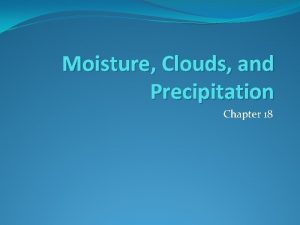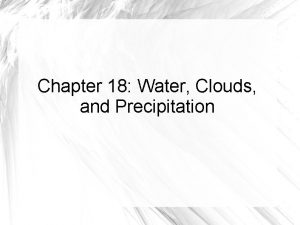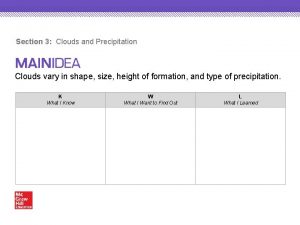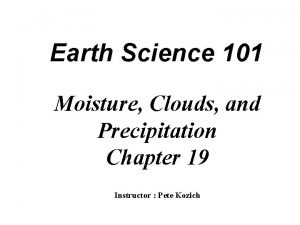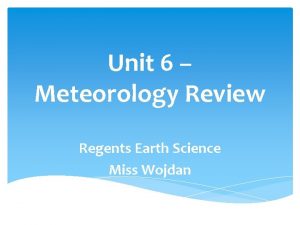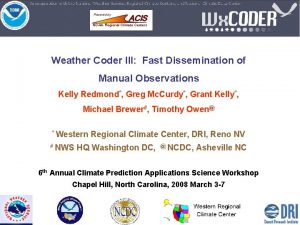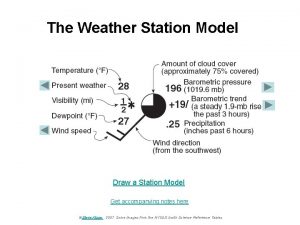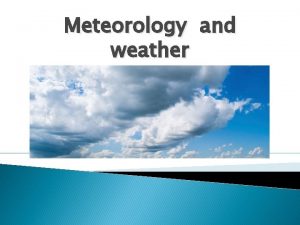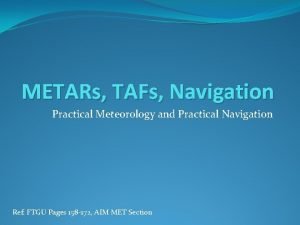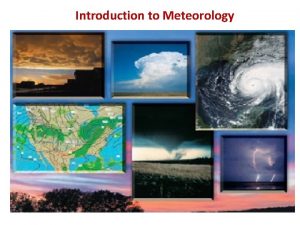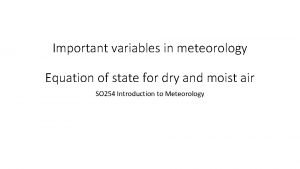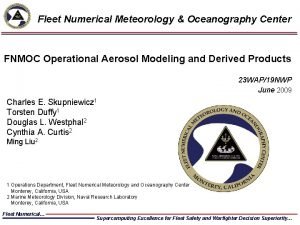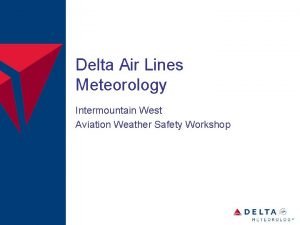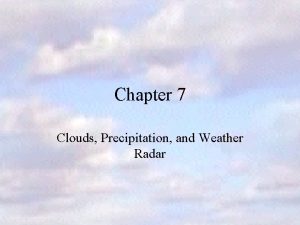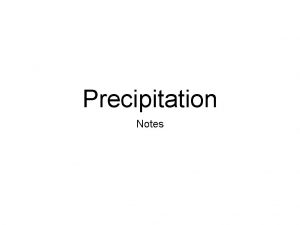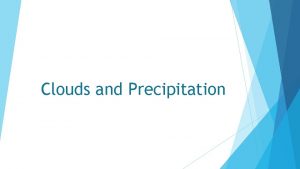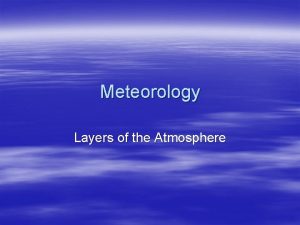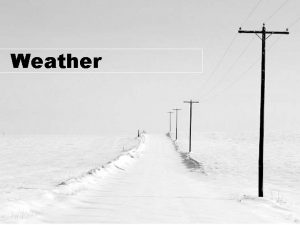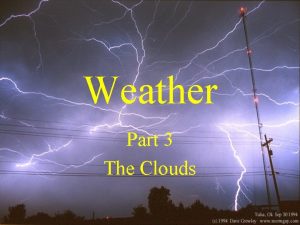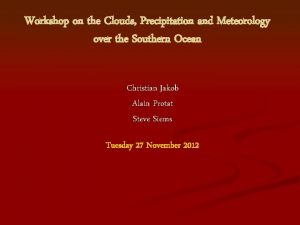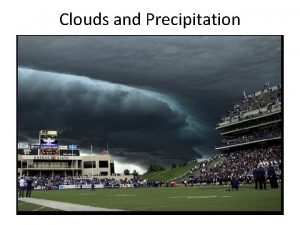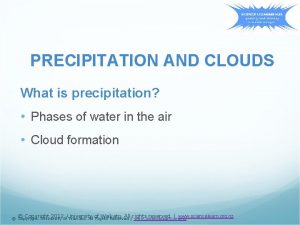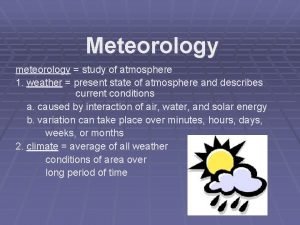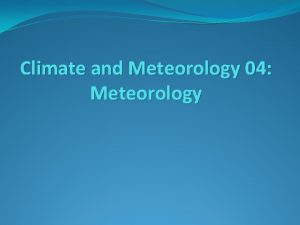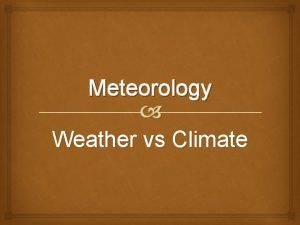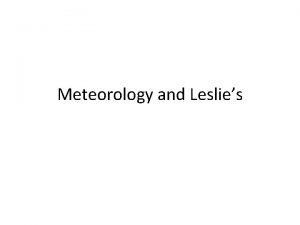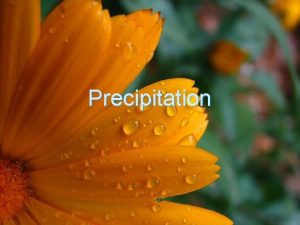Meteorology Notes Part III Clouds Precipitation Weather Map




























- Slides: 28

Meteorology Notes: Part III Clouds Precipitation Weather Map and Weather Systems Station Models

Ingredients Needed for Cloud Formation 1. Air at saturation (100% relative humidity or the dew point) 2. Cloud Condensation Nuclei (bits of microscopic dust and dirt)

HUMIDITY, PRECIPITATION AND CLOUDS Warmer air can hold MORE water vapor The rate of increase is EXPONENTIAL (it increases by a factor of 3 every 10°C) The amount of water vapor that can be held by air depends on the temperature. Condensation occurs at 100% relative humidity �Points A 1 -5 are all at 100% relative humidity. B 3 is 80%, C 3 is 33%, M is 50%. �For air at temperature and humidity of B 3, C 3 and M to reach saturation (100% relative humidity) it must either � ADD WATER VAPOR OR BE COOLED � �

How Can We Cool Air AIR COOLING occurs by: 1. Contact with cold surface (Forms fog – a “ground cloud” 2. Lifting of air up through the atmosphere (Forms what we generally call “clouds”

1. Contact with Cold Surface Ground level condensation may also occur when stationary air is cooled by a ground surface that cools, usually overnight. Cooling is fastest when no cloud cover exists to reflect outgoing longwave terrestrial radiation Cold surfaces are common in mountains, where snow reflects solar radiation and remains cold, cooling air in contact with the ground.

2. Uplift - How Clouds Form 4. Cloud formation continues as high as air rises. When air stops rising, cloud development stops. The more uplift, the taller and deeper the clouds 3. Relative humidity reaches 100% (saturation) at dew point temperature. Water vapor starts to condense on particles above this level - cloud base level. This level is called the lifted condensation level, or in other words, the cloud base. 2. Rising air expands with less pressure at altitude. This causes cooling, which causes relative humidity to rise. Air continues to rise as long as it is forced upwards, or if it has a higher temperature than the surrounding air. 1. Air at ground level is forced to rise. CLOUD TOP CLOUD BASE **Read this slide from the bottom to the top** “Parcel” of Air

Cloud Formation and Stability The size and shape of clouds depends entirely on the stability of the air. Stability is the ability of air to resist rising. An unstable atmosphere produces deep, puffy clouds. A stable atmosphere produces shallow, flat clouds. LIMITED UPLIFT CAUSES SHALLOW CLOUDS UPLIFT CONTINUES CLOUD BASE at CONDENSATION LEVEL Here, uplift is so strong that the cloud is very deep, and rainfall occurs.

WHY AIR RISES (1) – Orographic Lifting Cloud development stops when air is no longer forced up. Condensation level SNOWDONIA Westerly winds blow humid air onshore from the Atlantic Ocean Air sinks down on leeside of high land, contracts due to denser air, warms up, relative humidity falls and rainfall diminishes. Orographic Lifting – When air is lifted by encountering higher ground and having no where to go but up.

WHY AIR RISES (2) - CONVECTION Air meets air equally warm, stops rising, descends Solar radiation heats up ground surface LCL Air warms by contact with warm ground surface, becomes less dense and rises Rising air expands, cools, relative humidity rises until condensation of water vapour occurs above condensation level. WHY AIR RISES (3) - FRONTAL Rising air expands, cools and relative humidity rises until it reaches 100% (saturation) at condensation level above which clouds form as water vapour condenses on particles. Warmer, lighter air is forced to rise by denser Condensation cooler air. level Cooler, denser air sinks downwards and forces lighter, warmer air to rise

Naming Clouds - Cloud Types Clouds are named by their height and their shape. The four basic types of clouds based on shape are cirrus, cumulus, stratus, and nimbus. By adding a prefix to some of these basic cloud types you can also specify the height.


Precipitation Definition: All solid and liquid forms of water that fall from clouds Not all clouds produce precipitaiton • To produce precipitation, cloud droplets need to fall • -Coalescence occurs when cloud droplets stick together and grow to form larger droplets • -Once droplets are too large to be held in the air by gravity, they fall producing precipitation

• -Different types of precipitation are produced by different conditions at cloud level and the temperature changes on the way down. Snow Sleet

Sleet is rain that froze before it hit the ground Freezing Rain Regular Rain occurs when it is above freezing Freezing Rain freezes on contact and coats everything

Hail formation – only in T-Storms

How to Read and Understand the Weather Map H=High Pressure L=Low Pressure Cold Front Warm Front Occluded Front Lines are Isobars

Fronts • When two air masses collide there is a narrow region separating the two masses called a front. • Types of Fronts 1. Cold Front 2. Warm Front 3. Occluded Front 4. Stationary Front

• Cold Front Advancing cold air displaces warm air along a steep boundary • Characterized by a thin line of heavy to moderate precipitaion • Cold fronts are represented by a blue line with triangles.

• Warm Front Advancing warm air displaces cold air in a slow and gradual slope. • Characterized by extensive cloudiness and precipitation. – Why? • Represented by red lines with half circles.

Stationary Front • Blue line with triangles • When two air masses meet and neither advances into the other territory the boundary between the two masses is said to have stalled. – Characterized by small temp. and pressure difference between the masses. and red half circles.


Occluded Front • When cold air moves rapidly and overtakes the warm front. – The cold air wedges the warm air upward and it is squeezed upward between two cold fronts. • Represented by alternating purple triangles and half circles.



High Pressure Systems

Low Pressure Systems

Isobars

Pressure Gradient Force
 Gravimetry steps
Gravimetry steps Co precipitation and post precipitation
Co precipitation and post precipitation In order for clouds to form cooling air must be
In order for clouds to form cooling air must be Localized convective lifting examples
Localized convective lifting examples Section 3 clouds and precipitation
Section 3 clouds and precipitation Moisture clouds and precipitation
Moisture clouds and precipitation Hamlet act iii scene ii
Hamlet act iii scene ii On which station model would the present weather symbol
On which station model would the present weather symbol Wx coder
Wx coder Va handbook 5017
Va handbook 5017 Weather station model practice
Weather station model practice Tongue twisters spring
Tongue twisters spring Short poem about seasons
Short poem about seasons It's windy and rainy
It's windy and rainy Whether the weather is fine or whether the weather is not
Whether the weather is fine or whether the weather is not Heavy weather by weather report
Heavy weather by weather report Capital weather gang weather wall
Capital weather gang weather wall Cube wisc
Cube wisc How to draw a weather station
How to draw a weather station Cisk meteorology
Cisk meteorology National institute of meteorology
National institute of meteorology Penn state department of meteorology
Penn state department of meteorology The study of weather is
The study of weather is Tafs and metars
Tafs and metars Definition of meteorology
Definition of meteorology Meteorology hydrology and water management
Meteorology hydrology and water management Meteorology equations
Meteorology equations Fleet numerical meteorology and oceanography center
Fleet numerical meteorology and oceanography center Delta meteorology
Delta meteorology


